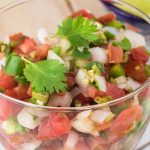Rice vermicelli is a staple in East Asian households. This article will discuss if it’s actually good for you or not.
Rice vermicelli noodles are healthy. They have no fat or cholesterol, less sodium content, and considerable amounts of selenium. They can be fortified with nutrients too. They are also great for a gluten-free diet. The only time they can be unhealthy is through preparation.
What kind of preparation can make them unhealthy, and are they better than rice? Scroll down to find out!
Are Rice Vermicelli Noodles Healthy?
Rice vermicelli noodles are healthy and this has to do with their components, preparation, and volume of consumption or how much of them one can eat.
Rice vermicelli, more commonly known as rice noodles, is a type of vermicelli noodle that’s made with rice, which makes it a rich source of carbohydrates (source: The Supplemental Nutrition Assistance Program).
In its most basic form, rice vermicelli is only made with two ingredients: rice and water. However, some brands add other ingredients such as cornstarch or tapioca starch to make its texture better.
Either way, rice vermicelli is gluten-free and is great for people with a gluten intolerance such as celiac disease or gluten sensitivity, or those who don’t want to have gluten in their diets.
For people who can’t have gluten, it can be hard to diversify their healthy diet. Instead of always having plain rice, rice vermicelli would be a great substitute!
Have you ever wondered if vermicelli noodles are gluten-free? It’s an important question for those mindful of their gluten intake. My guide goes beyond just answering that question, offering valuable guidance on identifying the right kind of vermicelli noodles for a gluten-free option that suits your needs.
A cup of rice vermicelli has no fat, no cholesterol, and is low in sodium at only 33 mg (source: Nutritionix). With these said, rice noodle is also low in fiber and protein, but significantly high in selenium at 4.5 µg (source: USDA FoodData Central).
Low fat, low cholesterol, and low sodium diets are especially great for heart disease, cardiovascular, kidney diseases, and other conditions.
Selenium is a mineral that acts as an antioxidant and a component of some enzymes. It helps prevent DNA and tissue damage which can result in inflammation and other health issues (source: Harvard T.H. Chan School of Public Health). Rice vermicelli can also be fortified, which some brands have done so.
In general, rice vermicelli is healthy. But because it can be eaten in many different ways such as cold, hot, in soup, with sauce, in stir fries like chow mien, in Vietnamese spring rolls, etc., it can turn unhealthy.
The addition of salt, soy or fish sauce, oils, fatty meats, and other ingredients can compensate for the lack of fat, cholesterol, and sodium in rice vermicelli dishes which can turn them into unhealthy food choices. Therefore, be cautious with what you prepare it with.
We also recommend treating rice vermicelli as you would any starchy food like plain rice, potatoes, or bread. Because it is rich in carbohydrates, it can easily add to calories when eaten too much of.
Are Rice Vermicelli Noodles Bad for You?
There’s nothing bad or unhealthy about rice vermicelli noodles. The only unhealthy thing about it is if you eat too much of it.
According to a study, too many carbohydrates can increase the risk of obesity, diabetes type 2, and cardiovascular diseases. A particular focus is given on rice (source: Obesity Pillars).
Another highly possible unhealthy version of rice vermicelli is instant ones. Like regular instant noodles, instant rice vermicelli noodles may not contain fat or cholesterol. However, they can be loaded with sodium.
Eating the regular unflavored rice vermicelli noodles is okay, but not too much of it. The same is true for instant rice vermicelli noodles. However, you need to stay away from it if you have a condition that makes you react to sodium negatively.
Is Vermicelli Healthier than Rice?
Plain white rice, when boiled, will contain water when it’s fully cooked. This makes it similar to rice vermicelli which will contain water when it is cooked.
The only difference they have is that rice vermicelli is made with water, and it is rehydrated by soaking it in water before it is cooked. This means that by already having water, it would take more vermicelli noodles to equate to the same volume of rice.
Other than this, both plain rice and rice vermicelli are healthy because they don’t have cholesterol or fat content, have little to no sodium, and are excellent options for a gluten-free balanced diet. Although, rice vermicelli has the upper hand for having a significant amount of selenium.
Another point to consider is their preparation.
If you’re in a time crunch, rice vermicelli is faster to prepare because it only takes 15 minutes or less to prepare, while rice takes a lot longer because it is in grain form.
Suppose you want to achieve perfectly cooked vermicelli noodles, take some time to dive into my guide and unlock the secrets of cooking perfect vermicelli noodles for different dishes.
Both plain boiled white rice and plain rice vermicelli are excellent choices for non-wheat, potato, or corn-based diets. You just have to choose what to add to them or serve them with.
We hope this article meets your inquiries about rice vermicelli!







Comments are closed.